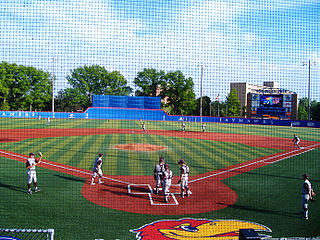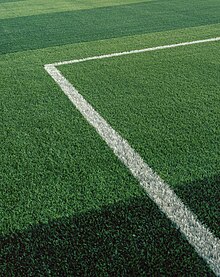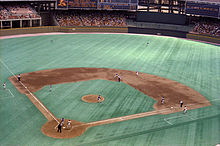
Rogers Centre is a multi-purpose retractable roof stadium in Downtown Toronto, Ontario, Canada, situated at the base of the CN Tower near the northern shore of Lake Ontario. Opened in 1989 on the former Railway Lands, it is home to the Toronto Blue Jays of Major League Baseball (MLB). Previously, the stadium was also home to the Toronto Argonauts of the Canadian Football League (CFL) and the Toronto Raptors of the National Basketball Association (NBA). The Buffalo Bills of the National Football League (NFL) played an annual game at the stadium as part of the Bills Toronto Series from 2008 to 2013. While it is primarily a sports venue, it also hosts other large events such as conventions, trade fairs, concerts, travelling carnivals, circuses and monster truck shows.

The NRG Astrodome, formerly and also known as the Houston Astrodome or simply the Astrodome, is the world's first multi-purpose, domed sports stadium, located in Houston, Texas, United States, with a record attendance of 68,266 set by George Strait in 2001.

Paycor Stadium, previously known as Paul Brown Stadium, is an outdoor football stadium in Cincinnati, Ohio. It is the home venue of the Cincinnati Bengals of the National Football League (NFL) and opened on August 19, 2000.

CEFCU ('sef-kyü) Stadium, formerly known as Spartan Stadium, is an outdoor athletic stadium on the west coast of the United States, located in the Spartan Keyes neighborhood of central San Jose, California. Owned by San José State University, the venue is the longtime home of Spartan football; it also hosts the university's commencement ceremony on Memorial Day weekend, and occasional high school football games. Known as Spartan Stadium for over eight decades, it was renamed in 2016.

FieldTurf is a brand of artificial turf playing surface. It is manufactured and installed by FieldTurf Tarkett, a division of French company Tarkett. FieldTurf is headquartered in Montreal, Quebec, Canada, and its primary manufacturing facility is located in Calhoun, Georgia, United States. With a design intended to more accurately replicate real grass, the new product rapidly gained popularity in the late 1990s.

Artificial turf is a surface of synthetic fibers made to look like natural grass, used in sports arenas, residential lawns and commercial applications that traditionally use grass. It is much more durable than grass and easily maintained without irrigation or trimming, although periodic cleaning is required. Stadiums that are substantially covered and/or at high latitudes often use artificial turf, as they typically lack enough sunlight for photosynthesis and substitutes for solar radiation are prohibitively expensive and energy-intensive. Disadvantages include increased risk of injury especially when used in athletic competition, as well as health and environmental concerns about the petroleum and toxic chemicals used in its manufacture.
Memorial Stadium is a stadium in Bloomington, Indiana, United States. It is primarily used for football, and has been the home of Indiana Hoosiers football since its opening in 1960. It is the tenth largest stadium in the Big Ten Conference, with a capacity of 52,626. The field has a conventional north-south alignment, at an approximate elevation of 771 feet (235 m) above sea level.

Bill Snyder Family Stadium is a stadium in Manhattan, Kansas. It is used for American football, and is the home field of the Kansas State University Wildcats football team. It is named after the family of head coach Bill Snyder. Over the past 31 seasons – from 1990 through the 2022 season – K-State is 169–51–1 (.767) at home.

Faurot Field at Memorial Stadium is an outdoor sports stadium in Columbia, Missouri, United States, on the campus of the University of Missouri. It is primarily used for football and serves as the home field for the Missouri Tigers' program. It is the third-largest sports facility by seating capacity in the state of Missouri, behind The Dome at America's Center in St. Louis and Arrowhead Stadium in Kansas City. In 1972, Memorial Stadium's playing surface was named Faurot Field in honor of longtime coach Don Faurot.

Eck Stadium is a baseball stadium in Wichita, Kansas, United States. It is located on the south side of 21st Street between Hillside and Oliver on the campus of Wichita State University in northeast Wichita.

Crumb rubber is recycled rubber produced from automotive and truck scrap tires. During the recycling process, steel and tire cord (fluff) are removed, leaving tire rubber with a granular consistency. Continued processing with a granulator or cracker mill, possibly with the aid of cryogenics or by mechanical means, reduces the size of the particles further. The particles are sized and classified based on various criteria including color. The granulate is sized by passing through a screen, the size based on a dimension or mesh. Crumb rubber is often used in artificial turf as cushioning.

Tartan Track is a trademarked all-weather synthetic track surfacing made of polyurethane used for track and field competitions, manufactured by 3M. The original production was in 1967, and the product was later reformulated to eliminate the use of mercury. Relative to some other surfaces, it lets athletes compete in bad weather without serious performance loss and improves their results over other surfaces. It also provides a more consistent surface for competition even under optimum weather. Similar tracks have become the standard for most elite competitions.

Shotwell Stadium is a stadium in Abilene, Texas. It was built in 1959, using Rice Stadium as a model. It was initially named the Public Schools Stadium. The first game played in the stadium was in the fall of 1959. Shortly after the first season, the stadium was renamed Shotwell Stadium, after P. E. Shotwell, a longtime football coach at Abilene High School.

A multi-purpose stadium is a type of stadium designed to be easily used for multiple types of events. While any stadium could potentially host more than one type of sport or event, this concept usually refers to a specific design philosophy that stresses multifunctionality over specificity. It is used most commonly in Canada and the United States, where the two most popular outdoor team sports—Canadian football or American football and baseball—require radically different facilities. Football uses a rectangular field, while baseball is played on a diamond with a large outfield. Since Canadian football fields are larger than American ones, the design specifications for Canadian facilities are somewhat less demanding. The particular design to accommodate both is usually an oval, although some later designs use an octorad. While building stadiums in this way means that sports teams and governments can share costs, it also presents some challenges.

Hoglund Ballpark is a baseball stadium in Lawrence, Kansas. It is the home field for the University of Kansas' baseball team. The stadium holds 3,000 people and opened for baseball in 1958. The stadium sits next to historic Allen Fieldhouse, home to the Kansas Jayhawks basketball teams. It is named after former Jayhawk baseball shortstop and former petroleum-industry CEO Forrest Hoglund.
The 15,000-capacity Dick Bivins Stadium is a stadium in Amarillo, Texas, USA, located at 800 S Marrs Street on the city's east side. It is primarily used for American football, and is the home field of the Amarillo Independent School District (AISD). During the season, many Texas Panhandle area high school football teams play regular and post-season games here. These schools include the four AISD-affiliated high schools: Amarillo High, Caprock High, Tascosa High, and Palo Duro High.
Poly-Turf was a brand of artificial turf in the early 1970s, manufactured by American Biltrite of Wellesley, Massachusetts. It was the first specifically designed for American football, with a patented layered structure which included a "shock pad" between the artificial grass and the asphalt sub-surface. It used polypropylene for its artificial grass blades, rather than the nylon used in AstroTurf and 3M's Tartan Turf.

Foote Field is a multi-purpose sports facility on the University of Alberta South Campus in Edmonton, Alberta, Canada, built as a legacy facility for the 2001 World Championships in Athletics. It was named for University of Alberta alumnus, former varsity track athlete, and philanthropist Eldon Foote, who donated $2 million toward the construction costs.
During the 1966 Houston Astros season in American baseball, the team finished eighth in the National League with a record of 72–90 (.444), 23 games behind the Los Angeles Dodgers.

Dayton Outpatient Center Stadium is a 3,500 seat artificial turf stadium located in West Carrollton, Ohio, on the campus of West Carrollton High School.






















